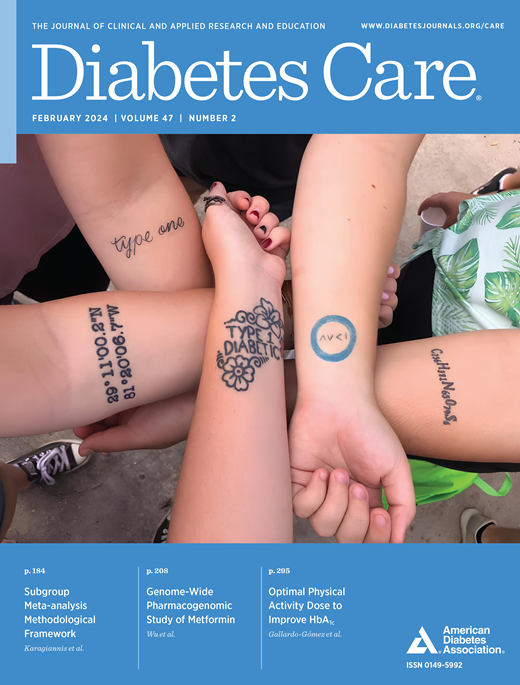Increasing Medication Use and Polypharmacy in Type 2 Diabetes: The Danish Experience From 2000 to 2020
IF 14.8
1区 医学
Q1 ENDOCRINOLOGY & METABOLISM
引用次数: 0
Abstract
OBJECTIVE Type 2 diabetes often coexists with other conditions that are amenable to pharmacological treatment. We hypothesized that polypharmacy among individuals with type 2 diabetes has increased since 2000. RESEARCH DESIGN AND METHODS Using Danish national registries, we established a cohort of all Danish individuals (aged ≥18 years) with type 2 diabetes between 2000 and 2020. We analyzed their medication use and prevalence of varying degrees of polypharmacy (≥5 or ≥10 medications), stratifying by age, sex, number of chronic diseases, and socioeconomic status. RESULTS The cohort grew from 84,917 patients in 2000 to 307,011 in 2020, totaling 461,849 unique patients. The number of daily medications used per patient increased from (mean ± SD) 3.7 ± 2.8 (in 2000) to 5.3 ± 3.2 (in 2020). The lifetime risk of polypharmacy was substantial, with 89% (n = 409,062 of 461,849) being exposed to ≥5 medications at some point and 47% (n = 217,467of 461,849) to ≥10 medications. The increases were driven by an expanding group of medications, with analgesics, antihypertensives, proton pump inhibitors, and statins having the largest net increase. Advanced age, male sex, lower socioeconomic status, and Danish ethnicity positively correlated with polypharmacy but could not explain the overall increase in polypharmacy. CONCLUSIONS Medication use and polypharmacy have increased among patients with type 2 diabetes. Although the implications and appropriateness of this increased medication use are uncertain, the results stress the increasing need for health care personnel to understand the potential risks associated with polypharmacy, including medication interactions, adverse effects, and over- and underprescribing.增加 2 型糖尿病患者的用药量和多重用药:丹麦 2000 年至 2020 年的经验
目的 2 型糖尿病患者往往同时患有其他可接受药物治疗的疾病。我们假设,自 2000 年以来,2 型糖尿病患者的多重用药情况有所增加。研究设计和方法 我们利用丹麦国家登记资料,建立了 2000 年至 2020 年期间所有丹麦 2 型糖尿病患者(年龄≥18 岁)的队列。我们按照年龄、性别、慢性病数量和社会经济地位对他们的用药情况和不同程度的多重用药(≥5 种或≥10 种药物)患病率进行了分析。结果 患者群从 2000 年的 84,917 人增加到 2020 年的 307,011 人,共有 461,849 名患者。每位患者每天使用的药物数量从(平均值±标准差)3.7±2.8(2000 年)增加到 5.3±3.2(2020 年)。终生使用多种药物的风险很大,89%的患者(461849 人中的 409062 人)在某一阶段使用的药物≥5 种,47%的患者(461849 人中的 217467 人)使用的药物≥10 种。增加的原因是药物种类不断增加,其中镇痛药、降压药、质子泵抑制剂和他汀类药物的净增加量最大。高龄、男性、较低的社会经济地位和丹麦种族与多重用药呈正相关,但不能解释多重用药的总体增长。结论 2 型糖尿病患者的用药和多重用药情况有所增加。虽然这种用药增加的影响和适当性尚无定论,但研究结果强调,医护人员越来越需要了解与多种药物治疗相关的潜在风险,包括药物相互作用、不良反应以及用药过多和过少。
本文章由计算机程序翻译,如有差异,请以英文原文为准。
求助全文
约1分钟内获得全文
求助全文
来源期刊

Diabetes Care
医学-内分泌学与代谢
CiteScore
27.80
自引率
4.90%
发文量
449
审稿时长
1 months
期刊介绍:
The journal's overarching mission can be captured by the simple word "Care," reflecting its commitment to enhancing patient well-being. Diabetes Care aims to support better patient care by addressing the comprehensive needs of healthcare professionals dedicated to managing diabetes.
Diabetes Care serves as a valuable resource for healthcare practitioners, aiming to advance knowledge, foster research, and improve diabetes management. The journal publishes original research across various categories, including Clinical Care, Education, Nutrition, Psychosocial Research, Epidemiology, Health Services Research, Emerging Treatments and Technologies, Pathophysiology, Complications, and Cardiovascular and Metabolic Risk. Additionally, Diabetes Care features ADA statements, consensus reports, review articles, letters to the editor, and health/medical news, appealing to a diverse audience of physicians, researchers, psychologists, educators, and other healthcare professionals.
 求助内容:
求助内容: 应助结果提醒方式:
应助结果提醒方式:


